Above: The Anvil Stone. Photo courtesy of the Armitt Library & Museum
There is more here than meets the eye, and less too. Schwitters hides some features of the work under subsequent layers of paint and plaster, some things have disappeared with decay, some, as explained in Chapter 4, were taken down after the artist’s death and exist now only in a few scant photographs, others have over time been removed and some of them have appeared on the art market.
Things that are there but obscured
A seashell (right), somewhat damaged, tucked away in the void behind the gilt mirror frame. A bone (left) that I never knew about, found by the Sculpcons team, covered by plaster but later revealed as the plaster decayed. There may be more hidden things. The x-ray photography carried out in 2016 revealed something of the Wall’s internals, but the technique can not be applied to the greater part of the artwork because of its being embedded in concrete.
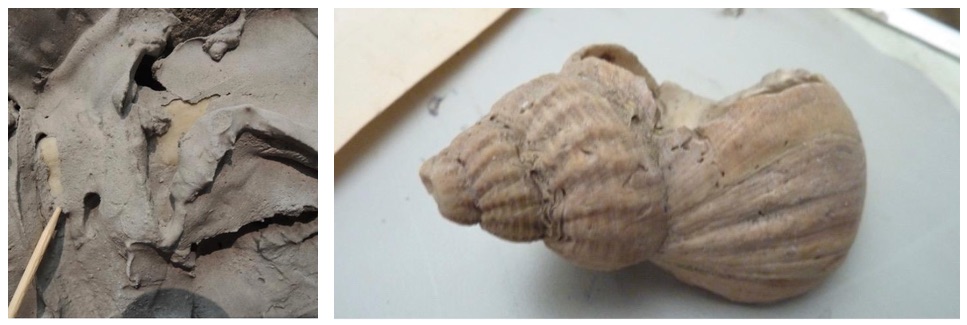
Photos: Sculpcons Ltd 2016
Things that were once there but have disappeared or been taken elsewhere
A piece of sculpture, roughly club-shaped, about three feet long, made of bamboos and plaster, is shown leaning against the left-hand return wall close to the corner in photographs before 1965.
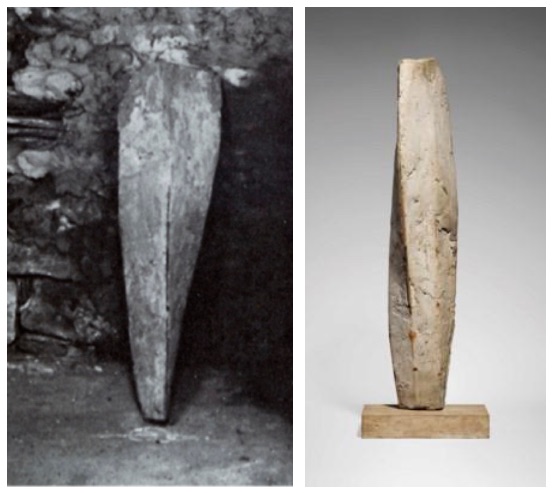
This piece has since been removed and exhibited, mounted vertically as an independent sculpture. Blouin Art Sales Index names it as Ohne Titel (Skulptur aus der Merz Barn, Elterwater 1), with the provenance: Harry Pierce, Elterwater, by descent from the artist in 1948, until at least 1964. Private collection, Port-la-Nouvelle, by whom acquired by 1969. Private collection. Galerie Gmurzynska, Cologne, by 1982. Acquired from the above by the present owner in 1982. It was most recently sold at Christie’s 27 February 2018, estimate £700,000 – £1,000,000.
Another piece of sculpture (or possibly a stone) appears in two images of the barn in the period between 1948 and the 1950s, in one instance alongside the piece above. It was not present in 1965, and I have not been able to trace its subsequent history or whereabouts. Perhaps it will turn up one day as Skulptur aus der Merz Barn, Elterwater 2.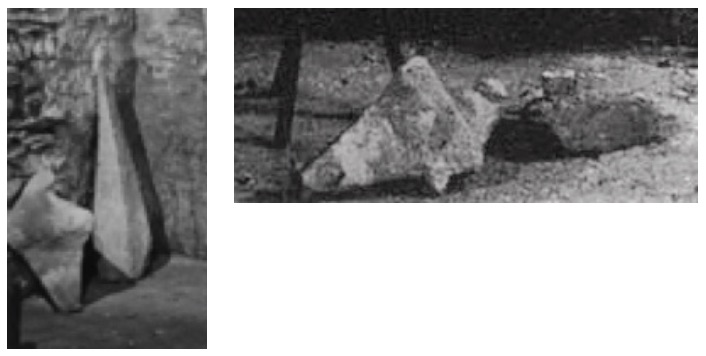
A small white plaster relief mounted on a projecting square of wood wedged in a crevice in the north wall, was present in 1965, and is now missing.
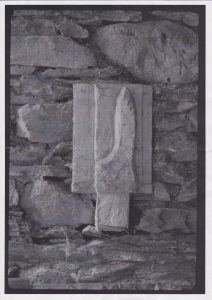
Photo: Mark Lancaster 1965
Several beck stones in organic shapes, notably one in a crescent shape, that in 1965 were on the sill of the south window among other places. This stone can be seen in the image below, front, second from right. It is now in the collection of the Armitt Library and Museum and known as the Anvil Stone.
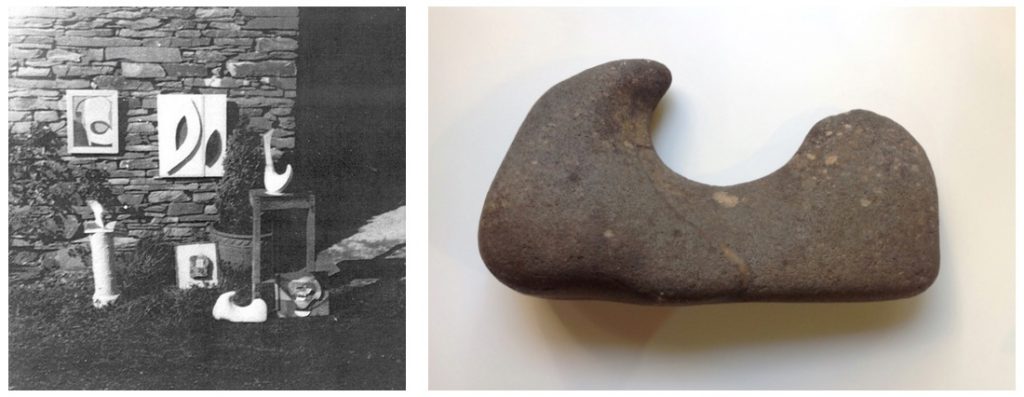
Photo left: Tom Mellor 1948; photo right: Armitt Library and Museum, Ambleside
The painted ‘snake’ stick that was pinned over the doorway, present in 1965, missing for many years, turned up at Bonhams saleroom in 2013.

Photo left: Abbot Hall Art Gallery; Photo right: Bonhams
Gentians
It was pointed out to me by Mr Pierce, while I was there for the removal, where Schwitters had included a small bunch of two or three gentians in the wall, held in place by a dab of plaster. These flowers are of an intense blue hue, and would have added a vivid note to the palette of the work.  The bunch was of course long decayed by the time I was there in 1965, but there was a trace in the plaster of where the stems had been, in the lower left-hand area. Sadly, the plaster was decayed and the mark was lost in the removal and restoration. Two points arise from this.
The bunch was of course long decayed by the time I was there in 1965, but there was a trace in the plaster of where the stems had been, in the lower left-hand area. Sadly, the plaster was decayed and the mark was lost in the removal and restoration. Two points arise from this.
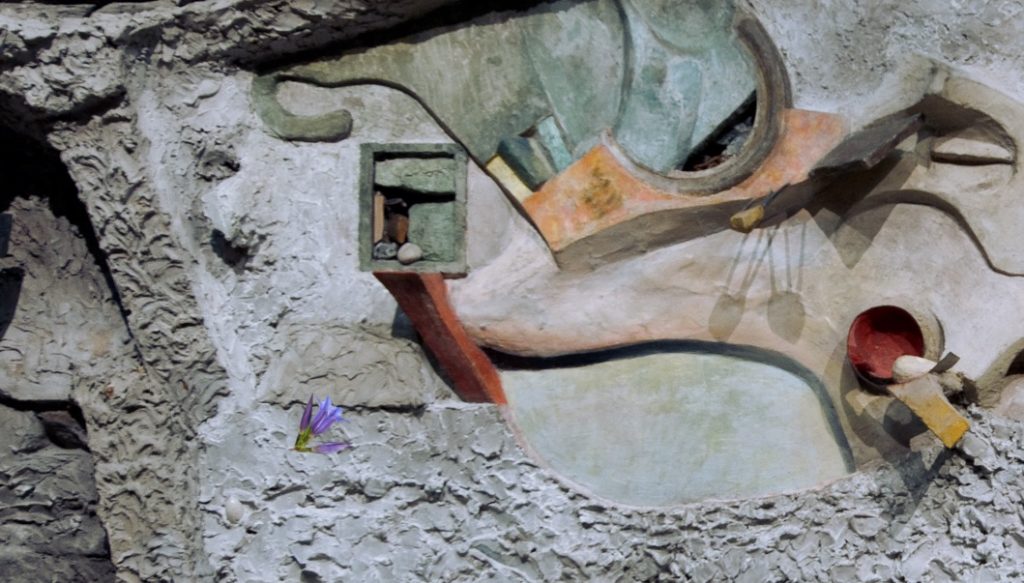 One, that I have long wanted to have the opportunity to put back some gentians to see how the colour interacts. Secondly the blooming period of the gentians. Schwitters picked the flowers in the garden of Cylinders (they were an autumn-flowering variety) and, if they still grow there, their blooming might give another fix on the timescale of the construction. In the image above I have added a little bunch of gentians, roughly in the right place, to suggest what their impact might have been.
One, that I have long wanted to have the opportunity to put back some gentians to see how the colour interacts. Secondly the blooming period of the gentians. Schwitters picked the flowers in the garden of Cylinders (they were an autumn-flowering variety) and, if they still grow there, their blooming might give another fix on the timescale of the construction. In the image above I have added a little bunch of gentians, roughly in the right place, to suggest what their impact might have been.
The ping-pong ball
Thanks to research by Heather Ross, uncertainty about the story of the Merzbarn ping-pong ball can be put to rest. Heather says:
“I visited Bill Davis yesterday, the son of Gwyneth Alban Davis, and asked him about the ping pong ball. Bill said that Gwyneth told him that during the Merzbarn exhibition at Cylinders (the one she typeset the text for) the ping pong ball that was placed in one of the cavities of the Merzbarn went missing a lot. They used to keep spare balls in a bucket so they could replace the ones that went missing. This was in 1948, just a few months after Schwitters died. I asked Bill to clarify where the ball was placed, was it in the rectangular frame that he saw it or whether he meant the gilt mirror frame. His answer was ‘None of the above! It was below in what looks like a circular tube painted red, if that makes sense’.“
Heather tried the experiment in October 2019 and kindly took photographs. This gives a sense of what it would have looked like at the time the Merzbarn was exhibited in 1948.
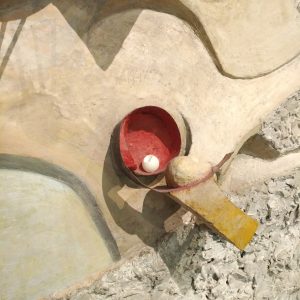
Photo: Heather Ross
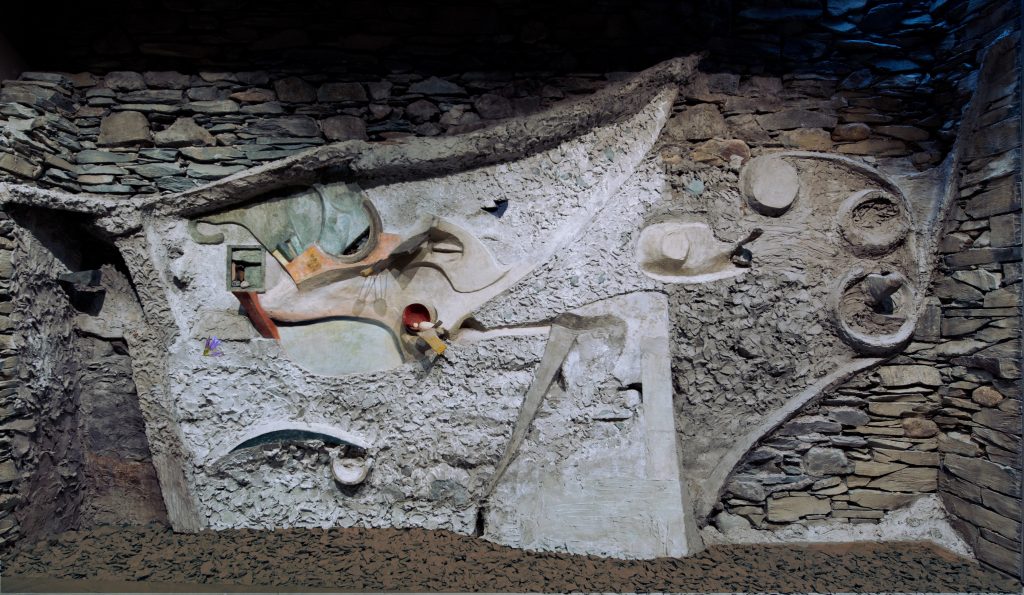
Photo compilation: Colin Davison, Heather Ross, FB
